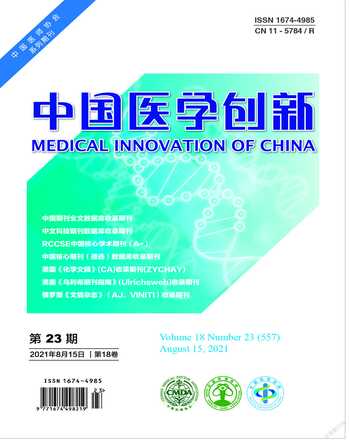甲状腺乳头状癌合并桥本氏甲状腺炎的研究进展
2021-03-25王欣郭建锋
王欣 郭建锋
【摘要】 甲状腺乳头状癌是最常见的甲状腺恶性肿瘤,桥本氏甲状腺炎是最常见的自身免疫性甲状腺疾病,很多研究表明两者间存在关联,并且在分子水平探讨了其机制,然而,两者间的因果关系至今仍不明确。本文旨在探讨两者分子水平关系,以及对甲状腺乳头状癌合并桥本氏甲状腺炎的临床特征分析与超声诊断。
【关键词】 甲状腺乳头状癌 桥本氏甲状腺炎 分子 超声检查
Research Progress of Papillary Thyroid Carcinoma Complicated with Hashimoto’s Thyroiditis/WANG Xin, GUO Jianfeng. //Medical Innovation of China, 2021, 18(23): -188
[Abstract] Papillary thyroid carcinoma is the most common thyroid malignancy, and Hashimoto’s thyroiditis is the most common autoimmune thyroid disease. Many studies have shown an association between the two, and the mechanism has been explored at the molecular level. However, the causal relationship between the two remains unclear. The purpose of this study is to explore the relationship between the two molecular levels, and to analyze the clinical features and ultrasound diagnosis of thyroid papillary carcinoma complicated with Hashimoto’s thyroiditis.
[Key words] Papillary thyroid carcinoma Hashimoto’s thyroiditis Molecule Ultrasonography
First-author’s address: Affiliated Suzhou Hospital of Nanjing Medical University, Suzhou 215008, China
doi:10.3969/j.issn.1674-4985.2021.23.045
甲状腺癌作为最常见的内分泌恶性肿瘤近几十年来发病率在世界范围内呈上升趋势。滤泡上皮起源的恶性肿瘤是甲状腺癌中最常见的类型,包括乳头状癌、滤泡癌、嗜酸细胞癌、低分化癌、未分化癌及鳞状细胞癌[1]。其中以乳头状癌(papillary thyroid carcinoma,PTC)最常见,占甲状腺癌的79%~94%[2]。桥本氏甲状腺炎(Hashimoto’s thyroiditis,HT)是一种以广泛淋巴细胞浸润、纤维化和实质萎缩为特征的自身免疫性炎症性疾病,近年来HT的年发病率也呈上升趋势。PTC与HT的发病率均升高且HT患者中PTC的发生率常常高于无HT患者提示两者间存在关联,HT与PTC的关系首次于1995年由Dailey等[3]提出。此后,PTC与HT之间的关系一直被人们争论,至今仍是研究和争论的热点之一。一项Meta分析显示HT与PTC以外的甲状腺癌没有关联而与PTC之间有关联[4]。
1 PTC與HT之间分子水平相关性
研究表明,PTC与HT之间具有很多共同的免疫组化和分子特征,包括p63基因的表达、RET/PTC癌基因重排、磷脂酰肌醇3激酶(PI3K)表达、人8-羟基鸟嘌呤糖苷酶1(hOGG1)基因的突变等[5-7]。在长期的HT中甲状腺滤泡上皮细胞积累的异常基因变化可能是PTC的前兆,这些基因改变的上皮细胞可能最终发展为PTC。例如RET/PTC癌基因是原癌基因RET的重排形式,为PTC的一个标志物。Rhoden等[6]报道68%的HT中发现RET重排,还发现了RET/PTC在HT中的水平与在部分PTC中的水平类似,推测RET/PTC癌基因重排出现在HT中可能是肿瘤发生的早期阶段。PI3K在调节细胞存活与凋亡之间的平衡、通过激活趋化因子受体和促进白细胞迁移的炎症反应中起着关键作用,Larson等[8]发现PI3K通路在HT、分化型甲状腺癌以及合并HT的分化型甲状腺癌中高表达,而在正常滤泡细胞中无表达,推测PI3K的活化可能抑制细胞凋亡,促进细胞增殖并最终发生肿瘤转化。hOGG1是DNA活性氧损伤的关键修复酶,hOGG1的杂合性缺失与头颈部肿瘤密切相关。Royer等[7]发现hOGG1突变发生在94%的PTC、73%的HT中,而在良性甲状腺肿中仅占8%,其中56%的PTC合并HT存在hOGG1突变则进一步支持这两种疾病之间的相关性。
HT患者TSH水平的升高可能促进PTC的发展[9-10]。一项包括40 929例受试者共计5 605个甲状腺癌的Meta分析发现升高的TSH更有可能促进甲状腺癌的发展[9]。Fiore等[11]发现TSH水平与合并HT的PTC强烈相关(比值比为1.11),并且使用I-T4治疗降低TSH水平从而降低了PTC风险。可能是由于TSH刺激甲状腺细胞,使滤泡内产生较高浓度的过氧化氢和自由基,对甲状腺细胞产生DNA变性、致突变作用,促进癌变;然而如果甲状腺功能完全减退,完全被自身免疫破坏的情况下,被破坏的甲状腺上皮细胞不能为TSH提供底物,则会降低PTC的风险。
2 合并HT的PTC的临床特征
很多研究显示合并HT的PTC患者较不合并HT的PTC患者更年轻,女性患者比重更高,肿瘤体积更小,肿瘤侵袭性更小,淋巴结转移率更低,预后更好[12-14]。Ahn等[15]发现合并HT的PTC患者临床分期更低,且在62个月的平均随访期间复发率更低、生存率更高。Lee等[16]的Meta分析显示HT的存在与PTC的无病生存率和总生存率之间存在正相关关系,且合并HT的PTC甲状腺外侵犯率更低,提示PTC患者HT的存在阻碍癌症的进展。
合并HT的PTC患者有更好的预后,可能是由于多数HT患者接受更严格的随访,从而导致早期发现PTC。然而除了筛查偏倚之外,HT可能存在一些固有的机制参与诱导、抑制肿瘤,例如Kimura等[17]认为合并HT的PTC患者中浸润的淋巴细胞为细胞毒性T细胞,其作为癌细胞杀手分泌白细胞介素-1以抑制甲状腺癌细胞的生长;Giodarno等[18]研究表明,HT的甲状腺细胞表达Fas,在HT中大量存在的白细胞介素-1诱导Fas表达导致甲状腺细胞凋亡。近几年的研究表明合并HT的PTC患者中BRAF V600E突变率更低(BRAF V600E与PTC更具侵袭性有关)[19-20]。
3 合并HT的PTC的超声诊断
超声是公认的首要检查甲状腺的影像学手段。HT的超声典型特征为甲状腺弥漫性低回声伴实质回声不均匀增粗、强回声分隔、无数低回声的微小结节形成(大小1.0~6.5 mm)。此外,有时可见孤立的结节伴或不伴甲状腺背景的改变(称结节性HT)[21],低回声及低回声小结节是由于大量的淋巴细胞和浆细胞浸润,甲状腺滤泡退化、消失所致,强回声分隔则代表纤维条索束。PTC的超声特征主要包括微钙化、垂直位生长、显著低回声、局部浸润及淋巴结转移,其次模糊不规则的边缘、实性成分等[22]。多项研究表明,合并HT的PTC的超声特征与不合并HT的PTC无显著差异[23-24]。有研究认为与不合并HT的PTC相比,合并HT的PTC患者中粗大致密钙化的频率升高而微钙化的频率降低,但差异并不显著[25]。
弹性成像作为有前景的成像技术,是超声检查有效的补充手段。弹性成像的原理为恶性结节与周围组织或良性结节相比更硬、形变更小。进入临床的弹性成像分为4种:应变弹性成像(strain elastography,SE)、瞬态弹性成像(目前专门用于肝脏组织硬度的测量)、声辐射力脉冲成像(acoustic radiation force impulse imaging,ARFI imaging)、声辐射力脉冲激励下的剪切波速度测量及成像[26]。SE通过弹性应变评分及应变率进行评估,ARFI包括声触诊组织成像(virtual touch tissue imaging,VTI)和声触诊组织量化(virtual touch tissue quantification,VTQ),可以定性、定量地評估组织硬度。一项包含3 531个甲状腺结节的Meta分析显示弹性应变评分、应变率诊断恶性结节的敏感性和特异性分别为82%和82%、89%和82%,高于灰阶超声的所有超声特征[27]。而ARFI对甲状腺恶性结节的预测较灰阶超声、SE具有更好的诊断效能[28]。HT由于淋巴细胞浸润、纤维化和实质性萎缩引起甲状腺实质硬度的改变。合并HT的PTC弹性应变评分和应变率的敏感性、特异性低于不合并HT的PTC,然而较高的弹性应变评分及较高的应变率仍是HT中恶性结节的主要预测因子[29]。Liu等[30]研究ARFI对HT中恶性结节的诊断价值,发现VTI的受试者曲线下面积为0.9,显著高于SE的0.68,说明在HT中ARFI诊断上仍然优于SE。总之无论是合并HT还是不合并HT,甲状腺恶性结节都较周围组织及良性结节显著更硬[29,31-32]。在HT中弹性成像依然是鉴别恶性结节的有效工具。
超声引导下细针穿刺抽吸术(ultrasonography-guided fine needle aspiration,USFNA)已经成为最准确及经济的评估甲状腺结节的方法,一项Meta分析显示,FNA诊断PTC的准确率并不弱于冰冻切片,具有几乎相同的敏感性(67% vs 66%)、特异性(95% vs 98%)和阴性预测值(94% vs 96%)[33]。然而基于FNA的研究显示,HT患者中PTC的发生率没有显著升高[34]。这就引申出FNA能否充分监测HT的问题。除了FHA固有的局限性如取材不足导致假阴性的诊断,一方面,如前所述HT中PTC更小,而FNA用于≥1 cm高度可疑的结节[35],因此对HT中可疑恶性结节的穿刺指征是否需要放宽;另一方面,PTC与HT有重叠的细胞学特征,HT中的结节不确定或可疑的细胞学诊断率较高,导致FNA诊断准确率的下降。尽管FNA有缺陷,它仍是手术前筛选PTC的一个很好的诊断程序。
4 展望
重叠的分子机制可能控制PTC的发生和HT的早期阶段。HT可能确实是PTC发展的一个危险因素。因此对HT中出现的结节应持谨慎态度,如果结节在超声上具有钙化、垂直位生长、显著低回声、模糊不规则的边缘等特征应高度怀疑恶性。可疑的超声特征与弹性成像组合可进一步减少不必要的FNA。弹性成像还可用于对FNA诊断不确定或可疑恶性的结节进行术前恶性风险评估及对FNA诊断为阴性的结节随访。合并HT的PTC具有较好的预后,更好地了解这种免疫反应及两种疾病的发病机制可能有助于未来制定合并HT的TC的预防措施以及发展新的治疗方法。有必要进行更多的大样本及前瞻性研究以进一步了解PTC合并HT。
参考文献
[1] Lam A.Pathology of Endocrine Tumors Update:World Health Organization New Classification 2017-Other Thyroid Tumors[J].AJSP:Reviews & Reports,2017,22(4):209-216.
[2]杨雷,王宁.甲状腺癌流行病学研究进展[J].中华预防医学杂志,2014,48(8):744-748.
[3] Dailey M E,Lindsay S,Skahen R.Relation of thyroid neoplasms to Hashimoto disease of the thyroid gland[J].AMA Arch Surg,1955,70(2):291-297.
[4] Resende De Paiva C,Grønhøj C,Feldt-Rasmussen U,et al.
Association between Hashimoto’s Thyroiditis and Thyroid Cancer in 64,628 Patients[J].Frontiers in Oncology,2017,7(4):53-62.
[5] Unger P,Ewart M,Wang B Y,et al.Expression of p63 in papillary thyroid carcinoma and in Hashimoto’s thyroiditis: a pathobiologic link?[J].Human Pathology,2003,34(8):764-769.
[6] Rhoden K J,Unger K,Salvatore G,et al.RET/Papillary Thyroid Cancer Rearrangement in Nonneoplastic Thyrocytes:Follicular Cells of Hashimoto’s Thyroiditis Share Low-Level Recombination Events with a Subset of Papillary Carcinoma[J].The Journal of Clinical Endocrinology & Metabolism,2006,91(6):2414-2423.
[7] Royer M C,Zhang H,Fan C Y,et al.Genetic alterations in papillary thyroid carcinoma and hashimoto thyroiditis: An analysis of hOGG1 loss of heterozygosity[J].Arch Otolaryngol Head Neck Surg,2010,136(3):240-242.
[8] Larson S D,Jackson L N,Riall T S,et al.Increased Incidence of Well-Differentiated Thyroid Cancer Associated with Hashimoto Thyroiditis and the Role of the PI3k/Akt Pathway[J].Journal of the American College of Surgeons,2007,204(5):764-773.
[9] Mcleod D S A,Watters K F,Carpenter A D,et al.Thyrotropin and Thyroid Cancer Diagnosis: A Systematic Review and Dose-Response Meta-Analysis[J].The Journal of Clinical Endocrinology & Metabolism,2012,97(8):2682-2692.
[10] Oyungerel B,金山,烏云图,等.桥本氏病患者血清促甲状腺激素浓度与其合并甲状腺乳头状癌的相关性研究[J].中华内分泌外科杂志,2016,10(4):269-271.
[11] Fiore E,Rago T,Latrofa F,et al.Hashimoto’s thyroiditis is associated with papillary thyroid carcinoma: role of TSH and of treatment with L-thyroxine[J].Endocr Relat Cancer,2011,18(4):429-437.
[12] Dvorkin S,Robenshtok E,Hirsch D,et al.Differentiated Thyroid Cancer Is Associated with Less Aggressive Disease and Better Outcome in Patients with Coexisting Hashimotos Thyroiditis[J].The Journal of Clinical Endocrinology & Metabolism,2013,98(6):2409-2414.
[13]伏桂明,王朝晖,陈义波,等.甲状腺微小乳头状癌合并桥本氏甲状腺炎的临床特点及CLNM危险因素分析[J].中华内分泌外科杂志,2020,14(4):274-278.
[14]伦语,张健,辛世杰,等.肿瘤浸润淋巴细胞与桥本甲状腺炎对甲状腺乳头状癌临床病理学特征的影响[J].中华普通外科杂志,2019(1):72-73.
[15] Ahn D,Heo S J,Park J H,et al.Clinical relationship between Hashimoto’s thyroiditis and papillary thyroid cancer[J].Acta Oncologica,2011,50(8):1228-1234.
[16] Lee J H,Kim Y,Choi J W,et al.The association between papillary thyroid carcinoma and histologically proven Hashimoto’s thyroiditis: a meta-analysis[J].European Journal of Endocrinology,2013,168(3):343-349.
[17] Kimura H,Yamashita S, Namba H,et al.Interleukin-1 inhibits human thyroid carcinoma cell growth[J].J Clin Endocrinol Metab,1992,75(2):596-602.
[18] Giordano C,Stassi G,De Maria R,et al.Potential involvement of Fas and its ligand in the pathogenesis of Hashimoto’s thyroiditis[J].Science,1997,275(5302):960-963.
[19]馬东林,朴颖实,毛美玲,等.甲状腺乳头状癌合并桥本甲状腺炎中BRAF V600E蛋白的表达及临床意义[J].临床与实验病理学杂志,2020,36(6):677-681.
[20] Zeng R C,Jin L P,Chen E D,et al.Potential relationship between Hashimoto’s thyroiditis and BRAF(V600E) mutation status in papillary thyroid cancer[J/OL].Head Neck,2016,38(Suppl 1):E1019-E1025.
[21] Oppenheimer D C,Giampoli E,Montoya S,et al.Sonographic Features of Nodular Hashimoto Thyroiditis[J].Ultrasound Quarterly,2016,32(3):271-276.
[22] Tessler F N,Middleton W D,Grant E G,et al.ACR Thyroid Imaging, Reporting and Data System (TI-RADS): White Paper of the ACR TI-RADS Committee[J].J Am Coll Radiol,2017,14(5):587-595.
[23] Zhou H,Yue W W,Du L Y,et al.A Modified Thyroid Imaging Reporting and Data System (mTI-RADS) For Thyroid Nodules in Coexisting Hashimoto’s Thyroiditis[J].Sci Rep,2016,6(1):410-417.
[24]王欣,郑凯,黄敏.合并桥本甲状腺炎的甲状腺乳头状癌临床病理及超声特征[J].中国医学影像学杂志,2018,26(10):747-751.
[25] Gul K,Dirikoc A,Kiyak G,et al.The association between thyroid carcinoma and Hashimoto’s thyroiditis: the ultrasonographic and histopathologic characteristics of malignant nodules[J].Thyroid,2010,20(8):873-878.
[26] Shiina T,Nightingale K R,Palmeri M L,et al.WFUMB Guidelines and Recommendations for Clinical Use of Ultrasound Elastography: Part 1: Basic Principles and Terminology[J].Ultrasound in Medicine & Biology,2015,41(5):1126-1147.
[27] Razavi S A,Hadduck T A,Sadigh G,et al.Comparative effectiveness of elastographic and B-mode ultrasound criteria for diagnostic discrimination of thyroid nodules: a meta-analysis[J].Am J Roentgenol,2013,200(6):1317-1326.
[28] Xu J M,Xu X H,Xu H X,et al.Conventional US, US elasticity imaging, and acoustic radiation force impulse imaging for prediction of malignancy in thyroid nodules[J].Radiology,2014,272(2):577-586.
[29] şahin M,çakal E,özbek M,et al.Elastography in the differential diagnosis of thyroid nodules in Hashimoto thyroiditis[J].Medical Oncology,2014,31(8):97-101.
[30] Liu B,Xu H,Zhang Y,et al.Acoustic radiation force impulse elastography for differentiation of benign and malignant thyroid nodules with concurrent Hashimoto’s thyroiditis[J].Medical Oncology,2015,32(3):50-58.
[31] Magri F,Chytiris S,Capelli V,et al.Shear wave elastography in the diagnosis of thyroid nodules: feasibility in the case of coexistent chronic autoimmune Hashimoto’s thyroiditis[J].Clinical Endocrinology,2012,76(1):137-141.
[32]费正东,邹大中.声触诊组织成像及定量技術对桥本氏甲状腺炎背景下甲状腺结节良恶性的诊断价值[J].医学影像学杂志,2020,30(1):133-137.
[33] Peng Y,Wang H H.A meta-analysis of comparing fine-needle aspiration and frozen section for evaluating thyroid nodules[J].Diagnostic Cytopathology,2008,36(12):916-920.
[34] Alcântara-Jones D M D,Alcântara-Nunes T F D,Rocha B D O,
et al.Is there any association between Hashimoto’s thyroiditis and thyroid cancer? A retrospective data analysis[J].Radiologia Brasileira,2015,48(3):148-153.
[35] Tessler F N,Middleton W D,Grant E G,et al.ACR Thyroid Imaging, Reporting and Data System (TI-RADS): White Paper of the ACR TI-RADS Committee[J].Journal of the American College of Radiology,2017,14(5):587-595.
(收稿日期:2021-06-24) (本文编辑:张爽)
